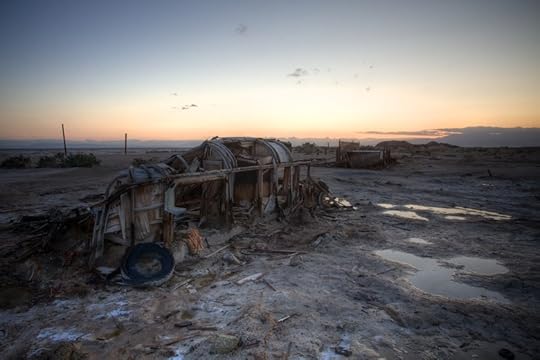Ransom Riggs's Blog, page 4
January 7, 2011
The Sherlock Holmes Handbook
Amidst the vast breadth of works written about Sherlock Holmes, this volume is unique. It seeks both the instruct the aspiring investigator in the ways of the master and to serve as an entree for the casual reader into the fascinating milieu, brilliant methods, and unorthodox habits of the world's most famous consulting detective.
For every reader who dreams of solving crimes in turn-of-the-century London, The Sherlock Holmes Handbook features skills that all would-be sleuths should know:
• How to Use Deductive Reasoning
• How to Analyze Fingerprints-Without Computers
• How to Master a Dozen Disguises
• How to Survive a Plunge over a Waterfall
Readers will also discover a host of information about Holmes and his universe: How was the real Scotland Yard organized? Could people back then really buy cocaine over the counter? And why were the British so terrified of Australia? Packed with fascinating trivia, evocative illustrations, and a classic Victorian design, The Sherlock Holmes Handbook will appeal to "Baker Street Irregulars" of all ages.
It's available for purchase from Amazon, Barnes and Noble and Powell's.
Notable Mentions
Here's a nice write-up from the LA Times.
I was on NPR's "Here and Now" to talk about both Sherlock and the Handbook. Listen to the segment.
"The Sherlock Holmes Handbook is a great tool for those unfamiliar with Sherlock Holmes ... or the perfect way to refresh your knowledge of the series." - Fandomania
"There are two types of people in the world: those who have heard of Sherlock Holmes and those who want to be Sherlock Holmes. This book is perfect for both audiences. For lovers of criminal intent, it features a range of skills that would-be sleuths and curious onlookers should know. Throughout the pages of this beautifully bound book, readers will also learn about the Victorian detective's universe ... a great way to get re-acquainted with the master." - Z!NK Magazine
"Nicely organized and illustrated, not to mention compact and durable, you can keep this volume in your coat pocket or under the seat of your hansom for those tough spots when stress and danger strain your memory. If you're the kind of person who aspires to use the power of analytical reasoning to bring justice to the world, this is your handbook. If you're the kind of person who aspires to learn the secrets of royalty, to the life of the mind, to do interesting things with zest and enthusiasm--this is your handbook." - Guyslitwire
Sample Chapter: How to Fake Your Own Death
"I owe you many apologies, dear Watson, but it was all-important that it should be thought I was dead, and it is quite certain that you would not have written so convincing an account of my unhappy end had you not yourself thought that it was true." — Sherlock Holmes, "The Empty House"
Any consulting detective as successful as Sherlock Holmes is sure to rack up an impressive list of powerful enemies, and sometimes—as Holmes decided was the case in "The Final Problem"—the best way to escape their vengeance is to fake one's own death. This is by no means an option for the faint of heart. Not only is it a cruel thing to inflict upon those who care for you, but it requires an exceeding amount of bother to execute the deed properly. Pray that you never have to embark upon the steps outlined here!
 1. Design a persuasive death scene.
1. Design a persuasive death scene. The best kind—and your only option, really—is a death that leaves no recognizable body behind. Explosions or fires are good choices, provided you plant a skeleton in the wreckage that may plausibly be identified as your own. Water-related tragedies in which the corpse is unrecoverable are also ideal, as was Holmes's choice in "The Final Problem"—he made it appear as though he'd tumbled over the lofty Reichenbach Falls, the treacherous bottom of which authorities didn't even bother to search for his remains. Holmes's footprints led up to the precipice and disappeared, leading all concerned to conclude he had fallen to his death—when in fact he had merely climbed over a nearby ledge, where he hid until the scene was deserted and he could make a stealthy escape.
2. Skip town.
As long as you remain near your old familiar haunts or anyone who might recognize you, you're in danger. Get as far as possible from your home and the scene of your "death," as quickly as you can. When Holmes miraculously returns to London in "The Empty House," he tells Watson about the exotic places he'd lived in the intervening three years:Tibet, Persia, Mecca, and Egypt, among other distant locales. Those were extreme choices, to be sure, but extraordinarily safe ones—the chances of his meeting someone there whom he had known prior to his "death" were low indeed.
3. Assume a new identity.
Though your body lives on, your former identity must die. Grow facial hair, change your walk, and develop a new accent to help bury obvious traces of your former self. While traveling far and wide, Holmes went undercover as a Norwegian explorer named Sigerson, whose exploits and discoveries were fantastic enough to make international headlines.Yet he was never recognized as Holmes himself, so convincing was this disguise.
4. Arrange access to a supply of money.
Travel is expensive, and you'll no longer have access to bank accounts or lines of credit established under your real name. You can always bring cash with you or deposit money into an anonymous offshore account, but keep in mind that making any sudden, last-minute transfers or withdrawals into that account before your death is extremely suspect behavior. If you're able to plan your death significantly in advance, make gradual, monthly transfers over a period of several years to avoid suspicion. Less advisable was Holmes's technique: He revealed himself to his brother Mycroft, who became Holmes's sole confidant and source of funds. Had Mycroft been compromised in some way, Holmes's secret would've been revealed, and his life put into considerable danger. Which brings us to the next point:
5. Reveal yourself to no one.
The wrenching heartache endured by your loved ones is your enemies' most convinc- ing proof you're really dead. Should their grief-stricken ululations seem forced or overly theatrical, someone is sure to smell a rat. This profound separation from friends and relations will undoubtedly be the most trying aspect of your ordeal, as even cold and logical Holmes admits—"Several times during the past three years I have taken up my pen to write to you," he apologizes to Watson—but such cruel alienation is necessary. Holmes explains why: "I feared your affectionate regard for me should tempt you to some indiscretion which would betray my secret."
6. Wait until your enemies are at their weakest to return.
With time, the fires of your enemies' vengeance will cool, and their guard will fall. They may themselves die or be jailed (for such are dangers of the criminal life) and when they are at their most defenseless, as Holmes judged his to be shortly before his dramatic resurrection, it's time to return home.
7. Minimize the shock to your friends and family.
When Holmes finally reveals himself to Watson, he does it in such a shocking way—which Holmes himself later confesses was "unnecessarily dramatic"—that poor Watson, a veteran of war and a man of sound constitution, faints on the spot. Imagine the effect such an appearance would have on the elderly or the anxious, and do your all to introduce yourself to them gradually. Save surprising flourishes for your enemies!
Strange Geographies: Travel Essays with a Twist
I love to travel -- but I've never been one for theme parks or resorts or pretty beaches. When I travel, I look for the places they don't tell you about in tourist guidebooks: the forgotten towns, the harsh landscapes, the weirdness at the margins that only the locals know about. I'm drawn to the blank spots on maps, the little uncharted questionmarks, and Strange Geographies is the result of a hundred weekend trips to try and fill in those blank spots, whether it be an obscure chain of recently-cannibalistic islands in the South Pacific or an airplane graveyard baking in the middle of the Mojave desert. I go hunting for stories in the fascinating but slightly unpleasant places that no rational person would use their vacation days to visit. In a world where everything's been discovered and mapped, I like to think that the new frontier is all the places we've forgotten about.
"Gloriously haunting photos." - Boingboing
The Happy, Haunted Island of Poveglia
In which I sneak onto a tiny, reputedly haunted, officially-off-limits island just two miles from the glittering Grand Canal of Venice, which boasts both a sprawling abandoned mental hospital and thousands -- perhaps hundreds of thousands -- of unmarked graves dating back to the days when Poveglia was used as a dumping ground for victims of the black plague. Given all that darkness, what I find is surprisingly cheerful and photogenic. Read the whole article.
The Mojave Desert's Airplane Graveyard
I thought it was a mirage the first time I saw it. I was driving through the wastes of the Mojave Desert, two hours from anywhere, when off in the shimmering distance appeared the silhouettes of a hundred parked jetliners. I pulled off and tried to get closer to them, but a mean-looking perimeter fence keeps onlookers far away. All I could do was stand and stare, wondering what the hell this massive armada of airplanes was doing here, silently baking in the 110 degree heat. For years afterward I'd ask people what they knew about it, and I kept hearing the same thing: the place has been on lockdown since 9/11, and they won't let civilians anywhere near the boneyard. But then my luck changed — I met a very nice fellow who works there, and with a minimum of cajoling on my part he agreed to take me beyond the high-security fence and show me around. Of course, I brought my camera. Read the article.

Vanuatu: The Happiest Place on Earth?
In 2006, the "happy planet index" named Vanuatu, a tiny archipelago nation in the South Pacific, the happiest place on Earth. Determined to find out what all the fuss was about (and having already been to Denmark, 2008′s "happiest country," and not finding it all that excessively cheerful a place), I booked a ticket and, two weeks ago, went there. Actually, I went there to go scuba diving and watch volcanos spurt lava from unsafe-by-Western-standards distances, and partly because whenever I told people where I was going they would scrunch up their faces and say where?, which pleased me (as if they had already forgotten season 9 of Survivor), but I figured as long as I was there I'd see if I couldn't get to the bottom of this happiness business, and maybe get a little happy myself. (I did manage to lose ten pounds and work on my tan — certainly a good start.) Read the whole article.
Bombay Beach may be the most famously depressing place in California; the poster child for the post-apocalypse. On the edge of the dying Salton Sea, an enormous body of water half the size of Rhode Island and so salty and polluted that by 2030 no fish will be able to survive in it, there is a town. There are several towns, actually, along the Salton's 70+ miles of rancid coastline, but the most in tact, the most iconically awful, is Bombay Beach.
It's a 10-by-10-block square of squat houses and mobile homes that was somebody's idea of paradise back when the town was incorporated in 1929. A beachy getaway 150 miles from the Pacific, it was supposed to be Palm Springs with water — but decades of hyper-saline farm runoff and other problems turned the sea into a nightmare; plagued by fish and bird die-offs and outbreaks of botulism that leave its banks littered with corpses and its beaches smelling like hell, all but the hardiest tourists and investors had fled the scene by the late 60s. Even worse, the Salton began to overflow its banks, flooding the bottom part of town repeatedly. The remains of dozens of trailers and houses that couldn't be saved still sit rotting, half-buried in salty mud, along what used to be the town's most prized few blocks of real estate. Read the article here.

There is a town on the South Island of New Zealand where jumping out of an airplane is considered normal behavior, and doing so will raise nary an eyebrow. While I was in country, I spent three days in the adrenaline-fueled hamlet of Queenstown, where if skydiving doesn't tickle your fancy you can bike down a mountain from a helicopter, rappel down a waterfall, climb any number of steep rock faces, take the controls of a small aircraft for twenty minutes ("absolutely no experience necessary!") or participate any other number of "x-treme" activities which all claim to let you feel the icy hand of death on your shoulder without actually shuffling you off this mortal coil.
In retrospect, I probably never would've skydived anywhere else; the fact that travelers in New Zealand (well, not all of them) skydive before tea and a nap on Sunday and seem otherwise sane and slip the fact that they jump out of planes so casually into their conversations (girl in a backpackers' hostel: "how was your skydive today?" other girl: "fine, not as good as yesterday though") slowly lulls you into thinking that this is a relatively safe, everyday activity. Read about my foolish escapade at fourteen thousand feet here.

Last year, while scouting for a short film that never came to fruition, some friends and I talked our way inside an empty, run-down hospital in Boyle Heights. The short was supposed to take place in a hospital, but after a few minutes wandering the halls of Linda Vista — alone and decidedly creeped-out — it became obvious that there was no way the place would work. It had been closed for twenty years, and it showed: there was dirt caked in layers on walls and mysteriously wet floors; windows were broken and doors hung off their hinges; ceiling tiles had fallen victim to moisture and gravity, and rats had chewed through the walls. We didn't have the money to make Linda Vista look like anything more than a horror movie — a few of which had actually been shot there over the years. Read the article.
[image error]
The Little Town That Los Angeles Killed
There are lots of dry lake beds in California, and to the untrained eye, Owens Dry Lake is just like the rest. But there is one key difference: while most of the state's stark, white alkali flats have been dry for thousands of years, Owens was an enormous, gem-blue lake stretching more than a hundred miles square — and an important habitat for millions of migratory birds — as recently as 1917. That's when the City of Los Angeles stole it, diverting the streams that fed Owens Lake into an aqueduct that watered the booming metropolis 200 miles to the south. As the lake slowly dried up, so did the once-thriving town of Keeler, which had been both a mining town and something of a lakeside resort. Nowadays, the "lakeside" town of Keeler is more than a mile from the "shoreline" of Owens Lake — little more than a collection of marshy mudpits surrounded by an endless expanse of salt flat, the surface of which can reach 150 degrees on hot summer days. Read the article.
[image error]
Ransom Riggs's Blog
- Ransom Riggs's profile
- 23619 followers





